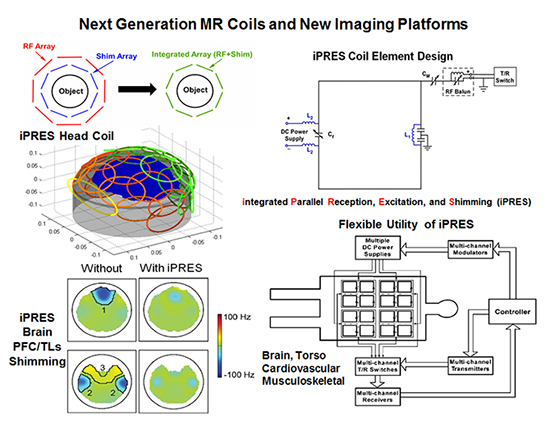Research Areas
Integrated Shimming and Radio-Frequency Array Integrated Parallel Reception, Excitation and Shimming (iPRES) for Magnetic Resonance Imaging
Current research in the Han Laboratory focuses on implementing the integrated Parallel Reception, Excitation and Shimming (iPRES) coil design for magnetic resonance imaging (MRI). The new iPRES technology combines radio frequency (RF) and direct currents in one single coil array rather than using separate arrays for parallel RF reception and B0shimming. iPRES relies on a novel circuit design that allows a radio frequency current (for excitation/reception) and a direct current (for B0 shimming) to coexist independently in the same coil without undesired interference. The underlying principle — that currents or waves at different frequencies can coexist independently in the same conductor or media without undesired interference between them — is simple and is found widespread in electrophysics and communications applications.
Taking advantage of multichannel RF receivers (e.g., 32) commonly available on modern scanners, the new concept integrates localized multicoil B0 shimming into a conventional RF phased array by innovated coil design. Therefore, conventional multiple channel receive arrays can be replaced by the new integrated shim-RF array. Compared with a conventional RF coil, the integrated coil provides the add-on ability for multicoil local B0 shimming without compromising the RF sensitivity in principle.
Compared with the standard B0 shimming coils on modern magnetic resonance imaging (MRI) scanners, multicoil local shimming has proven a powerful strategy for achieving an unprecedented homogeneous field in the human and mouse brain. The use of multicoil shimming has the potential to pave the way for high-field MR applications for which excellent magnetic field homogeneity is a prerequisite. Relative to recently innovated multicoil shimming methodology using separate shim and RF arrays, iPRES provides a dramatically increased signal-to-noise ratio in RF reception, particularly at brain cortices, and more effective local shimming due to proximity of the integrated coil to the subject.
This integrated shim-RF array is a new hardware platform that can provide a variety of MRI practitioners with improved image spatial and temporal resolution in vivo for both anatomical and functional MR imaging (e.g., at prefrontal cortex and temporal lobes of human and animal brains).

Left column, bottom image is from Han H, Song AW, Truong TK. Integrated parallel reception, excitation, and shimming (iPRES). Magn Reson Med. 2013;70(1):241-247. Right column, bottom image is from Han H, Song AW, Truong TK. Integrated parallel reception, excitation, and shimming (iPRES). Proc Int Soc Magn Reson Med. 2013;21:664.
Contact the Han Lab
8700 Beverly Blvd.
Davis Building, Room G-140
Los Angeles, CA 90048